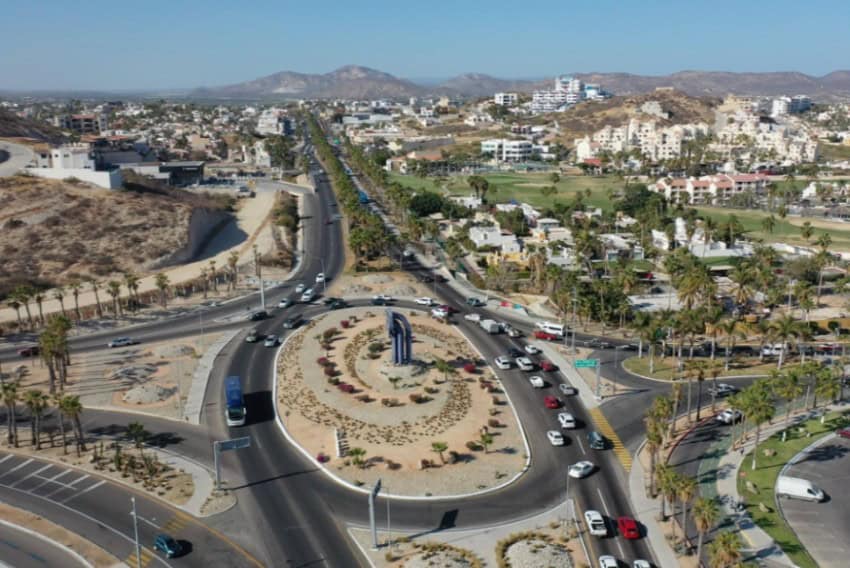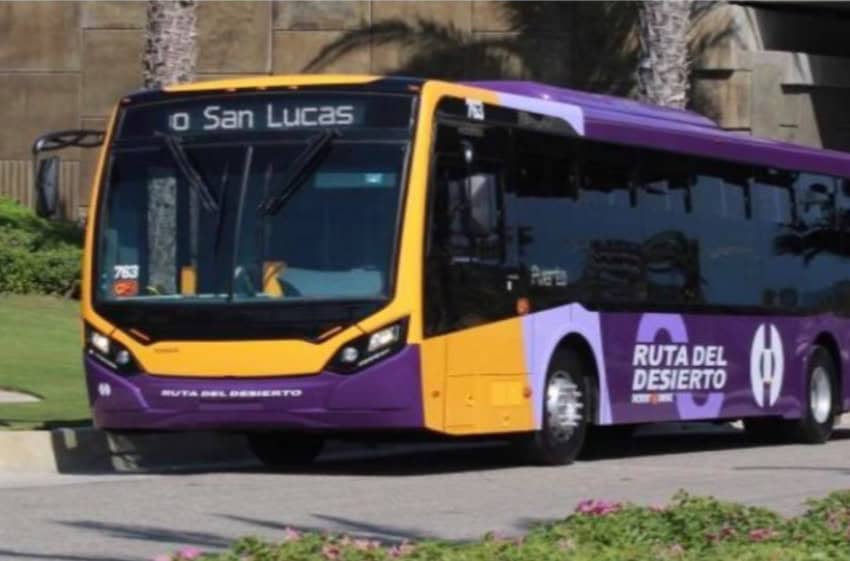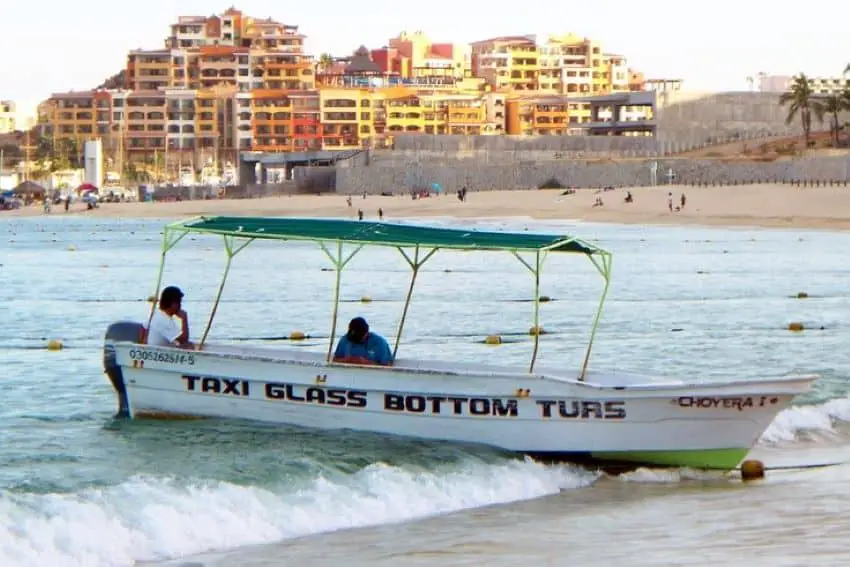The once sleepy Baja California Sur beach town has seen explosive growth in recent years, in terms of population, resorts, and available services. As a result, there is now a wealth of transportation options for visitors to Los Cabos, from rental cars and various types of airport shuttles and vans to Uber, bus, taxi, and water taxi services.
Which option is most practical or affordable often depends on the situation, unless of course one immediately acquires a rental car, in which case the only worries are navigating local traffic (and Spanish language street signs) and figuring out where to park when in busy downtown areas of Cabo San Lucas and San José del Cabo. Over a dozen car rental brands, including Avis, Budget, and Hertz, offer service at the Los Cabos International Airport.

It bears noting, though, that renting cars for the entirety of one’s stay can be expensive, even when factoring in the money that would have been spent on other forms of transportation. Most visitors thus opt for a mix-and-match approach, choosing transportation services as needed based on factors like price, comfort, safety, and convenience.
Taxis vs. Uber
Uber is often the best option to get around Los Cabos. The service is as comfortable and secure as that provided by local taxis but you can track when your driver will arrive and the rides are much cheaper. Going from Cabo San Lucas to San José del Cabo, a 20-mile ride, costs US $50 (800 pesos) and up via taxi. The same ride with Uber will be about US $20 to $30 It’s hard to be precise since like in the U.S., Uber uses dynamic pricing that raises rates during rush hour and other high usage times. But even with this variability, it’s still much more affordable.
However, Uber service isn’t available in all circumstances. The local taxi unions have political power and consistently seek to block competition, even when legal. A favored tactic, for example, is a blockade to prevent anyone from getting in or out of local hotels and resorts whose policies they disagree with. As a result of this hard-line approach, many resorts have caved and won’t allow Uber to pick up from their property. Confirm details with your driver to ensure onsite pickup is possible.
For several years after Uber arrived in the area in 2018, drivers were allowed to drop off passengers but not pick them up from the airport. That’s no longer the case — both services are now permitted — allowing visitors to choose what is by far the cheaper option. An airport run from Cabo San Lucas will cost US $50 or so from Uber but US $80 to $100 via taxi.
Other airport transportation options

You can’t visit Los Cabos without going to and from the airport to your hotel or resort. As a rule, you should ask your lodging provider what method they recommend, as some local luxury properties provide this service free or at a very reasonable cost for their guests. If you find the cost quoted excessive you may opt for an alternative. But it’s advisable to check first.
There are many private transport providers in Los Cabos. Shared shuttles are affordable at US $20 to $25 per person from downtown Cabo San Lucas — typically the farthest point served — and are fine when going to the airport for departure. But the service isn’t as enjoyable when arriving. Often you’ll have to wait at least half an hour for other passengers to clear customs, then the ride (with frequent stops) will take another hour or more to reach Cabo San Lucas.
Private cars, SUVs, vans, or limos are thus preferred for comfort and expedience, but these are naturally more expensive. Expert to pay US $85 or more for a private SUV, for example, although if you’re traveling with family or friends, this option may not cost much more than you would have paid collectively for a shared shuttle.
Buses vs. rental cars

The cheapest way to get around Los Cabos is via local buses. Everyone but the most adventurous will want to avoid the white buses, Transportes Colectivos, without creature comforts (sometimes it feels like the shocks are missing, too). These are for residents and visit off-the-beaten-path neighborhoods. The purple buses, Ruta del Desierto, are extremely comfortable and a good way to get from Cabo San Lucas to San José del Cabo for about US $4 to $5, or to resorts in the Tourist Corridor. This coastal corridor connects the cape cities and is home to many popular lodgings.
For longer trips, Autobuses Águila charges extremely low fares for super comfy buses that show movies en route. Naturally, they’ll be in Spanish, but tickets are only about US $11 from Cabo San Lucas to Todos Santos, US $12 to Los Barriles, and US $22 to La Paz, with bus depots located centrally, for the most part. The Cabo San Lucas terminal is at Plaza Golden Palace.
The only issue with Águila is that once you get to road trip destination favorites like Todos Santos or La Paz, you’ll be back to square one in terms of getting around. Uber or taxis are again an option if you want to visit, for example, beautiful beaches in La Paz like Balandra or El Tecolote. But rental cars, which allow you to take road trips or see attractions on your schedule, are far preferable, if a bit more expensive. Yes, a U.S. driver’s license is acceptable for local driving.
It’s important to note that the rate prices posted do not include insurance, which is highly recommended for driving in México. That will add another US $20 or so per day. If you’re staying at a small, budget-friendly hotel, you’ll also want to confirm that overnight parking is available. Local gas stations, meanwhile, are full service and tips are appropriate. There are no mileage charges but renters must refill the tank before returning the car.
Walking vs. water taxis

Walking is a great way to see the downtown areas of Cabo San Lucas and San José del Cabo. In the former, the city’s marina and Playa El Médano, its most popular beach, are centrally located and easily accessible on foot. However, walking from one end of the marina boardwalk to the other takes about 30 minutes. This is a particularly relevant fact for cruise ship passengers, who are ferried via tenders to the main dock (muelle principal), which is a very long walk from Médano Beach.
Water taxi drivers are often seen soliciting fares on the marina boardwalk for those who’d like to take a shortcut. These small outboard-powered boats (called pangas locally) also provide a lower-priced albeit bare-bones alternative for Land’s End tours or trips to Playa del Amor (Lover’s Beach), which is only reachable via boat.
Chris Sands is the Cabo San Lucas local expert for the USA Today travel website 10 Best, writer of Fodor’s Los Cabos travel guidebook, and a contributor to numerous websites and publications, including Tasting Table, Marriott Bonvoy Traveler, Forbes Travel Guide, Porthole Cruise, Cabo Living and Mexico News Daily. His specialty is travel-related content and lifestyle features focused on food, wine and golf.
